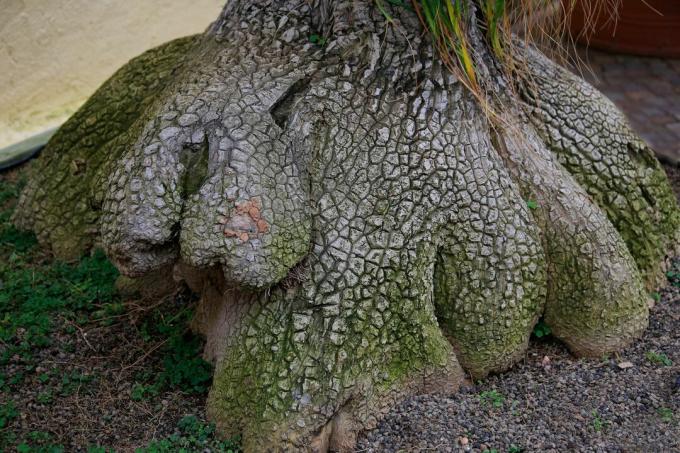The popular houseplant with the funny name doesn't need a lot of nutrients. Here we show how to properly fertilize the elephant's foot.

Of the Elephant foot (Beaucarnea recurvata) is a bizarre plant, with its strangely bulbous trunk. But this definitely has its raison d'etre. If you want your elephant's foot to thrive, it helps to better understand the function of its trunk and to take a closer look at the home of the exciting plant.
contents
- Fertilizing elephant feet: the right time
- Recognize deficiency symptoms in the elephant foot
-
What should you fertilize the elephant's foot with?
- Organically fertilize elephant feet: this is the best way to go about it
- Fertilize elephant foot minerally
- Fertilize the elephant's foot with home remedies: coffee grounds and Co.
Elephant feet are native to southern Mexico, where they form light forests in dry regions. The soil there is sandy and poor in nutrients and it rains a lot, but only over the summer months and in autumn. But the elephant's foot has come up with something to withstand drought and nutrient shortages: a thickened trunk. Water is stored in it, something like what we know from a cactus. Since hardly any nutrients can be absorbed during the water-poor period, these are also temporarily stored here. In addition, the plant grows very slowly and therefore doesn't need much to make ends meet. Elephant feet can cope with a deficiency rather than an excess and should therefore only be fertilized carefully.
Fertilizing elephant feet: the right time
During the sunnier time in winter, the elephant's foot goes into winter break. When it gets warmer and, above all, lighter again, it starts to grow. First of all, the elephant's foot uses up its accumulated resources in the trunk. Fertilization should therefore only be started in late spring, and even then rather cautiously. It is enough if you provide your elephant foot with nutrients once or twice a month in the warm summer months. If autumn is heading, you should slowly reduce the fertilization before the elephant's foot takes its winter break again.

Recognize deficiency symptoms in the elephant foot
Positive news: Deficiency symptoms are almost non-existent in elephant feet. However, this also means that there are other reasons why your elephant's foot looks dissatisfied. Brown leaves, for example, can be a sign of waterlogging or drafts. You can find out more about this in this article on the Elephant foot.
Since the elephant's foot is extremely frugal, it will not get any symptoms of deficiency with more or less regular fertilization in late spring and summer. However, if the plant is never fertilized, it cannot grow.
What should you fertilize the elephant's foot with?
It is best to provide elephant feet with liquid fertilizer. Since they are only watered very rarely, nutrients in solid form cannot otherwise be dissolved well and are therefore of little use to the plant. In general, however, you should fertilize the plant sparingly. Here is ours Plantura citrus & mediteranean fertilizer just the thing. This liquid fertilizer provides the perfect nutrient ratio for the elephant's foot: a lot of potassium, which has a positive effect on the water balance, and relatively little nitrogen. In no case should the fertilizer contain more nitrogen than potassium or phosphorus.
Organically fertilize elephant feet: this is the best way to go about it
In the wild, the elephant's foot predominantly thrives on mineral soils with a low humus content. However, you can also fertilize your elephant's foot organically. In liquid form, the fertilizer can be mixed well into the irrigation water and is therefore easy to administer to the plant. Before you use the fertilizer, however, you should moisten the soil, otherwise the plant will be overwhelmed. A good and extremely cheap alternative is, for example, coffee grounds. You should be very careful with very nitrogenous substances such as manure, compost or various organic fertilizers. These are not suitable as the fertilizer should contain more potassium and phosphorus than nitrogen.

Fertilize elephant foot minerally
The elephant's foot gets along well with mineral fertilization, but only in moderation. Since mineral fertilizers are usually available quickly, there is an increased risk of over-fertilization. Therefore do not fertilize more often than once or twice per summer month and use a cactus fertilizer.
Fertilize the elephant's foot with home remedies: coffee grounds and Co.
Coffee grounds are made for the elephant's foot. It provides sufficient phosphorus and potassium and relatively little nitrogen. This prevents over-fertilization. Coffee grounds also have an acidic effect on the soil. Especially when the pH value of the soil tends to be too high, this can help bring the soil environment into a range between 5.8 and 6.8 - i.e. slightly acidic.
Are you not a coffee drinker? No problem, many cafés are happy to dispose of their coffee grounds on request. Even the big Starbucks chain has now agreed to do so.
For your elephant foot to thrive, you should not only fertilize it, but also trim it occasionally. You can find out how to do this correctly in our article on the subject Cut and repot the elephant foot.
